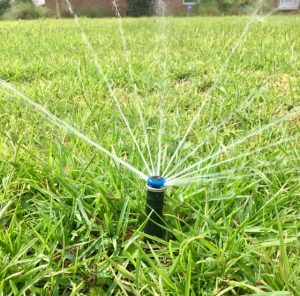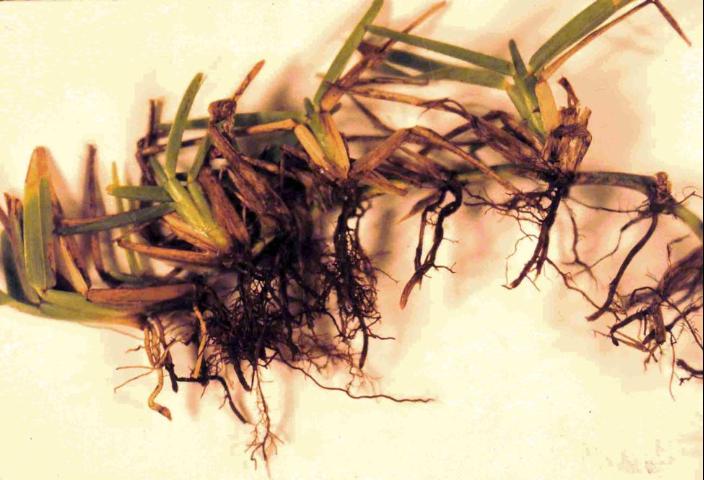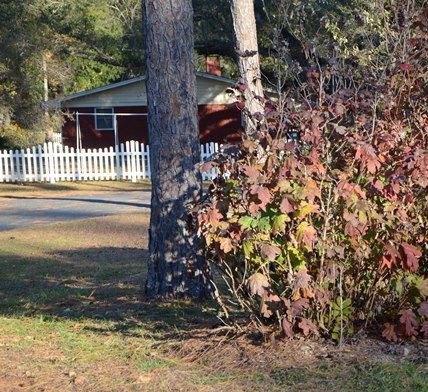
by Larry Williams | Oct 31, 2024
So far, our fall has been unusually dry with warmer temperatures. Even though our average annual rainfall is around sixty-two inches per year, we don’t always receive rain exactly when we need it. There are times when we need to apply additional water. During dry weather, employ the following water management practices to improve the water efficiency of your lawn and landscape.
Mulching helps conserve water. On bare ground, about sixty percent of the water can be lost through evaporation. A two to three-inch layer of mulch will help hold onto the water so the plants can use it. Try to mulch the entire root zone when possible or at least apply mulch all the way around the plants out to the end of the branches.

Irrigate on as needed basis during dry periods. Credit: Larry Williams
When watering, a thorough soaking to wet the soil to a depth of six to eight inches is much better for plants than light, frequent watering. Three to five gallons of water applied to one spot under the canopy of trees or shrubs should thoroughly saturate the root zone in that location. During dry periods, as a general rule), twenty-five percent of the root system, when watered thoroughly, can absorb all the water a plant requires at any given time.
When watering lawns, apply one inch of water per week when we are not getting rain. Although many sprinklers have irrigation rates of ¼ inch per hour, some may apply up to one inch per hour. Measure your irrigation rate and uniformity by placing several open-top containers of the same size under the sprinkler and see how long it takes to apply a known amount of water such as ½ inch.
An efficient irrigation program on turf should not begin until the lawn grass shows signs of moisture stress. Symptoms include a dull and bluish-green color and leaf blades folding. The most efficient time to irrigate is between sunset and sunrise because of less evaporation, less wind and lower temperatures. Early morning is the next most effective time to irrigate while midday is the least efficient.
Avoid fertilizing drought-stressed plants. Fertilizers are chemical salts and will dehydrate roots when water is in short supply. If you need to apply a pesticide, make certain the plant is not wilted at the time and spray during early morning or late afternoon. You should also avoid unnecessary pruning of plants during drought. Pruning encourages new growth, which has a high demand for water.
For more information on watering efficiently and drought tolerant plants, contact the UF/IFAS Extension Office in your county or visit the following website: http://gardeningsolutions.ifas.ufl.edu/care/irrigation.

by Blake Thaxton | Sep 29, 2016

St. Augustinegrass roots rotted due to take-all root rot. (Photo Credit: IFAS Photos)
The crisp air of fall is upon us. Maybe. We live in northwest Florida and we are not experiencing the change in weather just yet. With the change in weather coming, we are having specific issues in turfgrass lawns and are sure to have others in the near future. Extension agents in the western panhandle have come into contact with several St. Augustine lawns with symptoms and signs of take-all root rot (Gaeumannomyces graminis var. graminis) and we can soon expect with cooler temperatures for Large Patch to be rearing its ugly head.

Early aboveground symptoms of take-all root rot. (Photo Credit: IFAS Photos)
Take-all root rot is sometimes referred to as a “stress disease”, as it is brought on by stressful weather conditions and improper management. Periods of rainfall can provide conditions for the disease to affect all warm season grasses. Other stresses such as improper mowing height, improper irrigation, and improper fertilization can worsen the situation. For example, St. Augustinegrass, except dwarf cultivars, should be mowed at 3.5 to 4 inches and the mower should never remove more than 1/3 of the leaf blade at any cutting. With the current high temperatures and prolonged periods of rainfall it can be difficult to follow this practice. When a homeowner does not mow the lawn in a timely manner and lets the lawn grass get much too high and cuts more than 1/3 of the grass blade, this can become a stress to the lawn. Fungicide sprays can be made during favorable environmental conditions, before symptoms are seen to protect from infection with take-all root rot for high valued properties. To learn more about take-all root rot refer to this University of Florida/IFAS Extension publication: Take-all Root Rot
With the fall weather coming, please be sure to read and learn about large patch disease as well. This can brought on by temperatures of less than 80 degrees and high humidity or extended periods of rainfall. Read the University of Florida/IFAS Extension publication for more information: Large Patch
For any other information needed regarding proper lawn management, please visit Your Florida Lawn or contact your local UF/IFAS Extension office.

by Les Harrison | Nov 18, 2014

Even though the lawn and landscape are going dormant, there is much which can be done now to prepare for Spring 2015.
Even though it is not officially winter and the landscape is becoming dormant. With the exception of live oak trees, all the plants and trees which lose their leaves are now dropping them to the ground.
For the north Florida homeowners consumed with plans for the holidays, late November is a tempting time to let the landscape take care of itself during this winter’s nap.
This is not necessarily the best plan. There are plenty of task to handle which will make the upcoming growing season more productive and easier.
First on the list of winter’s lawn and garden task is taking a soil sample. It is simple, inexpensive, and efficient from both an economic and environmental standpoint.
Stop by the local UF/IFAS County Extension Office to pick up a free kit which is used to mail the samples, with a processing fee, to the UF Soil Test Lab. The report is usually returned in under two weeks.
Depending on the analysis chosen, the report will deliver the samples soil pH, or the nutrients needed and the soil pH. This is useful information for the spring and summer growing season, and during winter’s dormant period.
People with wood burning fireplaces should be particularly aware of the soil pH which is a measure of acidy or alkalinity. The pH range helps determine the potential success of plants, vegetables and shrubs which will grow in the sampled soil.
Fireplace ash is alkaline and an excellent soil amendment, if the soil pH is too low. However, if the soil pH is too high, then the fireplace ash only aggravates the existing problem of growing desirable plants and grasses.
Many Florida soils tend to have a high concentration of phosphate, an important and useful plant nutrient in the right quantities. Having a soil analysis early which identifies the amount of phosphate available in the land gives the homeowner or garden manager plenty of time to locate a source of blend-fertilizer with the correct amount of phosphate.
The second task on the list is to manage the leaves, mulch and thatch. Each has the potential to be an asset to the landscape, or a hazard.
Leaves should be raked up before they have the time to smother the grass. A carpet of leaves in the yard may appear very seasonal, but usually work against the objective of those who ultimately want a green grassy yard.
As leaves decompose, they leach acidic nutrient into the soil. This is especially true of oak leaves and pine needles.
Another issue is leaf litter and thatch, produced from grass clippings, which will provide an ideal breeding ground for fungi and diseases. The cool, moist recesses common to thatch will incubate any number of problems which will appear in the spring to ruin the perfect yard.
Rake the leaves and use in flower beds or compost heaps. The shrubs will overwinter better with the leaf insulation which keeps the root zone at the correct moisture level and provides desirable nutrients to the plants.
Dethatch lawn mechanically to remove excess debris. Use the excess organic material as mulch or in a compost pile.
The landscape will show its appreciation by returning in a healthy and strong condition in Spring 2015.
To learn more about winter landscapes visit the nearest UF/IFAS County Extension Office. Additional information will be found in the Florida Lawn Handbook




